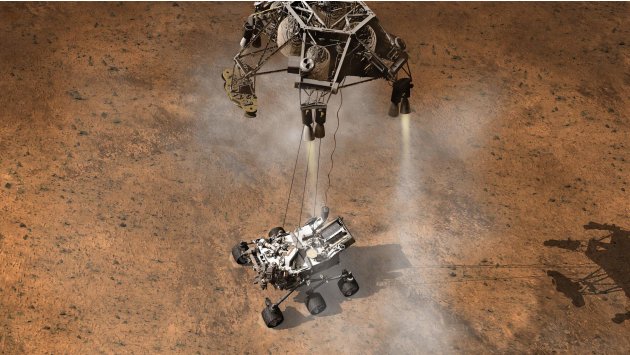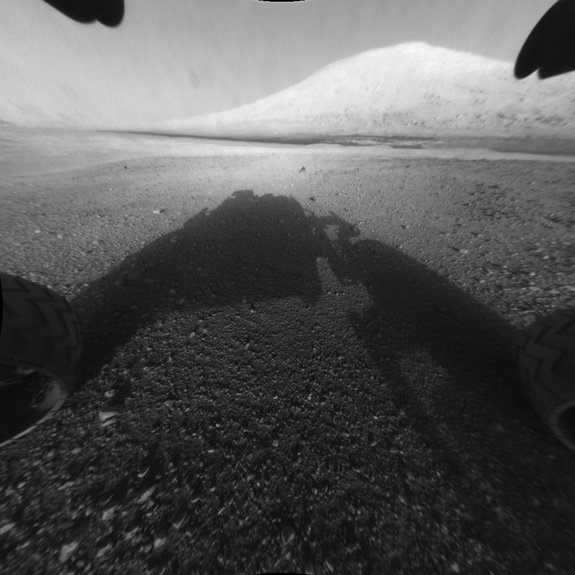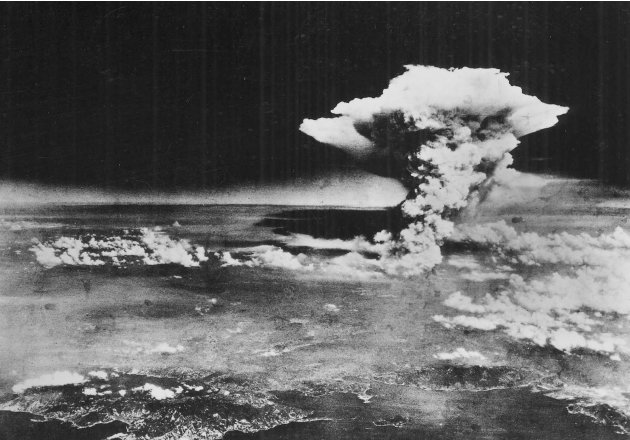This full-resolution version of one of the first images taken by a rear-left Hazard-Avoidance camera on NASA's Curiosity rover, was released on Aug. 6, 2012.The image was originally taken through the "fisheye" wide-angle lens, but has been "lin
This handout image from NASA, one of the first images from the Curiosity rover which landed on Mars the evening of August 5, 2012, with camera dust cover in place, shows the wheel of the rover after it successfully landed on Mars. The rover landed on the Martian surface shortly after 10:30 p.m. Pacific time on Sunday (1:30 a.m. EDT Monday/0530 GMT) to begin a two-year mission seeking evidence the Red Planet once hosted ingredients for life, NASA said.
In this photo released by NASA/JPL-Caltech/Univ. of Arizona, NASA's Curiosity rover and its parachute, left, descend to the Martian surface on Sunday, Aug. 5, 2012. The high-resolution Imaging Science Experiment (HiRISE) camera captured this image of Curiosity while the orbiter was listening to transmissions from the rover.
In this image from NASA TV, shot off a video screen, one of the first images from a second batch of images sent from the Curiosity rover is pictured of its wheel after it successfully landed on Mars. The video screen was inside the Mars Science Laboratory (MSL) team inside the Spaceflight Operations Facility for NASA's Mars Science Laboratory Curiosity rover at Jet Propulsion Laboratory in Pasadena, California August 5, 2012.The rover landed on the Martian surface shortly after 10:30 p.m. Pacific time on Sunday (1:30 a.m. EDT Monday/0530 GMT) to begin a two-year mission seeking evidence the Red Planet once hosted ingredients for life, NASA said.
This color thumbnail image was obtained by NASA's Curiosity rover during its descent to the surface of Mars on Aug. 5 PDT (Aug. 6 EDT). The image was obtained by the Mars Descent Imager instrument known as MARDI and shows the 15-foot (4.5-meter
This image from Curiosity's Mars Descent Imager illustrates the roughly circular swirls of dust kicked up from the Martian surface by the rocket motor exhaust. At this point, Curiosity is about 70 feet (20 meters) above the surface. This dust c
An artist's concept of NASA's Mars Science Laboratory spacecraft approaching Mars. The Curiosity rover is safely tucked inside the spacecraft's aeroshell. The mission's approach phase begins 45 minutes before the spacecraft enters the Martian atmosphere. It lasts until the spacecraft enters the atmosphere. For navigation purposes, the atmospheric entry point is 2,188 miles (3,522 kilometers) above the center of the planet. This illustration depicts a scene after the spacecraft's cruise stage has been jettisoned, which will occur 10 minutes before atmospheric entry.The landing is set for late evening August 5, 2012
Artist’s concept depicts the NASA Mars Science Laboratory Curiosity rover, a nuclear-powered mobile robot for investigating the Red Planet’s past or present ability to sustain microbial life.
The target landing area for NASA's Mars Science Laboratory mission is the ellipse marked on this image of Gale Crater on Mars (top L). The ellipse is about 12 miles long and 4 miles wide (20 kilometers by 7 kilometers). The MSL Curiosity rover is set to for landing about 10:31 p.m. on August 5, 2012, Pacific Daylight. This view of Gale Crater is derived from a combination of data from three Mars orbiters. The view is looking straight down on the crater from orbit. Gale Crater is 96 miles (154 kilometers) in diameter. Mount Sharp rises about 3.4 miles (5.5 kilometers) above the floor of Gale Crater.

This Aug. 26, 2003 image made available by NASA shows Mars photographed by the Hubble Space Telescope on the planet's closest approach to Earth in 60,000 years. Mars is set to get its latest visitor Sunday, Aug. 5, 2012, when NASA's new robotic rover, named Curiosity, attempts to land there. Mars has been a prime target for space exploration for decades, in part because its climate 3.5 billion years ago is believed to have been warm and wet, like early Earth.
Engineers work on a model of the Mars rover Curiosity at the Spacecraft Assembly Facility at NASA's Jet Propulsion Laboratory in Pasadena, Calif., Thursday, Aug. 2, 2012. After traveling 8 1/2 months and 352 million miles, Curiosity will attempt a landing on Mars the night of Aug. 5, 2012. (AP Photo/Damian Dovarganes)

This artist's concept depicts the moment that NASA's Curiosity rover touches down onto the Martian surface. The entry, descent, and landing (EDL) phase of the Mars Science Laboratory mission begins when the spacecraft reaches the Martian atmosphere, about 81 miles (131 km) above the surface of the Gale crater landing area, and ends with the rover safe and sound on the surface of Mars which is set for late evening August 5, 2012. The sheer size of the Mars Science Laboratory rover (over one ton, or 900 kilograms) would preclude it from taking advantage of an airbag-assisted landing. Instead, the Mars Science Laboratory will use the sky crane touchdown system, which will be capable of delivering a much larger rover onto the surface. It will place the rover on its wheels, ready to begin its mission after thorough post-landing checkouts

This artist's concept depicts the rover Curiosity, of NASA's Mars Science Laboratory mission, as it uses its Chemistry and Camera (ChemCam) instrument to investigate the composition of a rock surface. ChemCam fires laser pulses at a target and views the resulting spark with a telescope and spectrometers to identify chemical elements. The laser is actually in an invisible infrared wavelength, but is shown here as visible red light for purposes of illustration. The rover is set to land on Mars in the late evening August 5, 2012.
An engineering model of NASA's Curiosity Mars rover is seen from the rear in a sandy, Mars-like environment named the Mars Yard at NASA's Jet Propulsion Laboratory in Pasadena, California July 25, 2012. NASA's Mars rover was on its final approach to the red planet on Sunday, heading toward a mountain that may hold clues about whether life has ever existed on Mars, officials said.
Members of the Mars Science Laboratory/Curiosity team, which includes rover drivers and scientists, test out an engineering model of its next generation Mars rover, dubbed "Curiosity", in the desert near Baker, California May 10, 2012. According to a press release from NASA, the rover is 89 days away from its August appointment with Mars.
A cameraman, part of a news crew, films as NASA tests an engineering model of its next generation Mars rover, dubbed "Curiosity", in the desert near Baker, California May 10, 2012. According to a press release from NASA, the rover is 89 days away from its August appointment with Mars.
Members of the Mars Science Laboratory/Curiosity team, which includes rover drivers and scientists, test out an engineering model of its next generation Mars rover, dubbed "Curiosity", in the desert near Baker, California May 10, 2012. According to a press release from NASA, the rover is 89 days away from its August appointment with Mars.



























